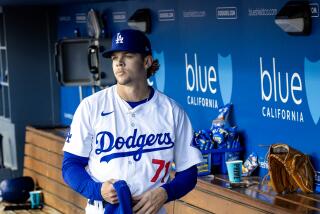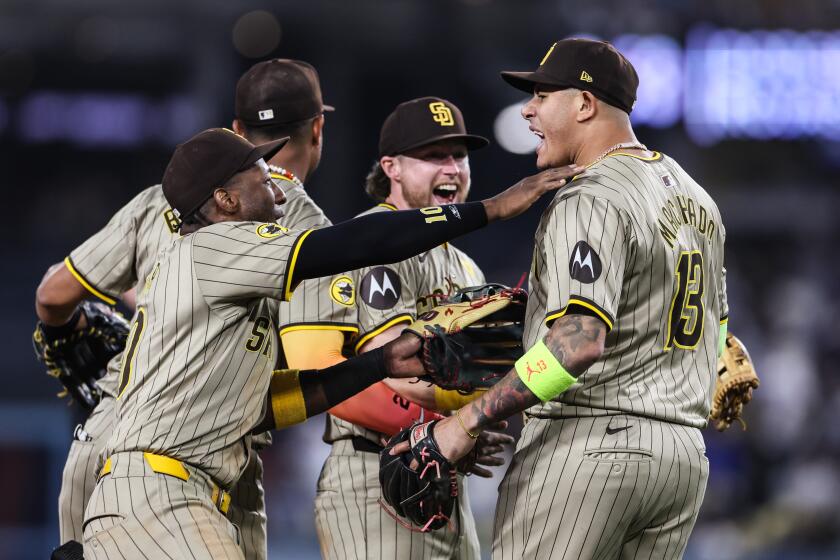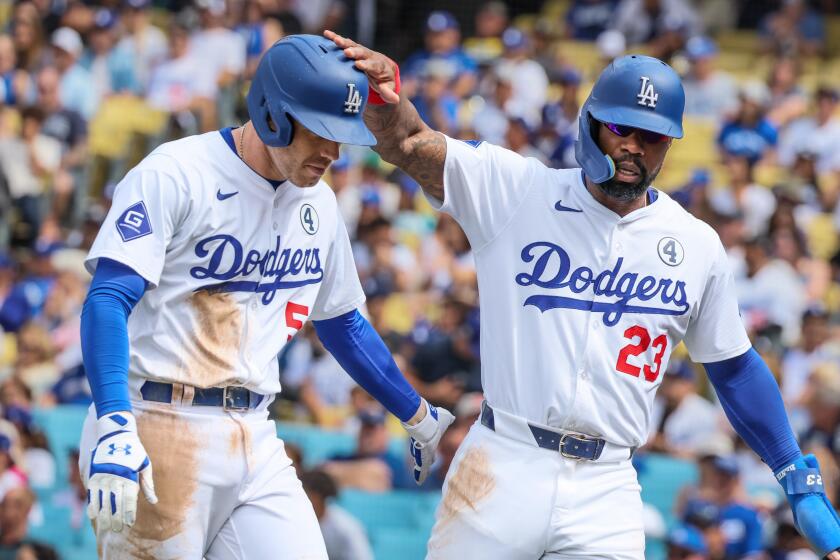Dodgers pitcher Alex Wood gets another chance to audition for starting rotation
In the summer before his junior year of high school, Alex Wood sat at a computer and composed a series of emails. He addressed them to the coaches at the 15 to 20 colleges where he wanted to play baseball. He was a gangly left-hander from Charlotte, N.C., with a goofy delivery, but he exhibited enough confidence to showcase himself.
One of the respondents was David Perno, who ran the baseball program at the University of Georgia. Perno went to see Wood at a showcase event that fall. The mechanics looked strange, and Wood’s mien was “non-athletic,” Perno recalled. On the mound, though, he turned ferocious.
“He was like a quiet assassin,” Perno said. “There wasn’t a lot of emotion. But you could see it in his eyes, in his demeanor.… He was going to be better than you that day.”
Wood carried that attitude through three years at Georgia. He still harbors it in his role as the most malleable member of the Dodgers pitching staff in 2017. He feels compelled to prove himself, and on a team as deep as these Dodgers (8-8), that quality is indispensable.
Wood (1-0, 1.00 earned-run average) will make his second start of the season Friday in Arizona. He is auditioning for a job he may not be able to win — at least not permanently. The uncertainty with Rich Hill’s blister created an opening for Wood. But the Dodgers do not expect Hill to miss the entirety of the season, and Manager Dave Roberts has mentioned Julio Urias’ impending arrival in late April.
That leaves Wood in limbo. The situation allowed the Dodgers to observe Wood as a reliever and perhaps forecast his role for later in the season. He gave up two runs in 3 2/3 innings in a spot start against the Cubs early this month. The revelation thus far is his performance in two dynamic, multi-inning appearances of scoreless relief.
As a starter, Wood’s fastball sat around 90 mph. His velocity jumped to 94-95 mph in those relief outings, according to Brooks Baseball. He faced 19 batters and did not allow a hit.
“Woody’s been tremendous,” President of Baseball Operations Andrew Friedman said. “The velo and life on the fastball, both off-speed pitches have been really good. We were confident coming into spring training. But then watching the way he performed in spring training only gave us more confidence. And how he’s come out of the gate has only strengthened that.”
Despite Wood’s 3.39 career ERA as a starter, some rival scouts harbor doubts about his ability to excel in the rotation. In 2016, he held opposing hitters to a .572 on-base plus slugging percentage in the first turn through the order. On his second pass through, the opposing OPS rose to .660. By the third time, the OPS mushroomed to .879. For context, Corey Seager led the Dodgers with an .877 OPS last season.
For years, many talent evaluators viewed Wood’s true calling as a high-leverage reliever. The gawkiness of his approach often offset the results of his performance. Wood underwent Tommy John surgery after his senior year of high school. Few pitchers throw like him.
In his windup, Wood cradles the ball in his left hand and rips downward to hide the ball behind his back. His glove extends in the opposite direction, rendering him, momentarily, like a man on a balance beam. He lunges toward the plate with a three-quarter delivery.
“My whole life, I always threw different than other guys,” Wood said. “But from a mechanical standpoint, I was always pretty sound and consistent. That’s why nobody ever messed with me. I always compared it to hitting: You see guys do tons of crazy different things in the box, but as long as the results are there, and as long as they’re getting into the spots they’re supposed to get to, they’re fine.”
Perno cackled over the phone when asked about Wood’s mechanics. As Wood brushed aside the competition in the Southeastern Conference, scouts flocked to his games. They formed a refrain, stressing how Wood should clean up his delivery and alter the plane of his curveball to a more traditional, 12-to-6 drop.
Neither Perno nor Wood listened. Wood trusted his own style. Perno felt confident that Wood’s changeup could compensate for the imprecision of his side-winding curve. Both were right. “His breaking ball still sucks, and he’s got the same mechanics he did at the University of Georgia,” Perno said.
Wood raced through the minor leagues. Atlanta drafted him in the second round of the 2012 draft. He reached the majors a year later. In 2014, he won 11 games and posted a 2.78 ERA. Yet the Braves were still willing to ship him to Los Angeles in the summer of 2015 in a convoluted, three-team deal that also brought Luis Avilan, Mat Latos and Jim Johnson to the Dodgers.
The trade wounded Wood’s pride. His body already was in pain. He had suffered a bone bruise in his right foot in his final outing as a Brave. He pounded on the injured foot with each pitch, which caused his balance to waver and his arm slot to drop. “When I look back at that video, it makes me sick how poor my mechanics had gotten,” Wood said.
Wood felt he corrected the issues during the winter. He won a spot in the team’s rotation for 2016. In six starts April 29-May 30, he posted a 2.80 ERA with 50 strikeouts in 35 1/3 innings. The string of dominance ended when his elbow began to bark. Wood underwent surgery and returned as a reliever in September. He gave up one hit in four outings, hinting at his potential for the future.
The Dodgers may capitalize on that ability in October. Wood gets to start Friday, but Hill and Urias remain in the wings. Until they arrive, Wood will continue to audition. He is used to it.
“I feel like this is the best I’ve been in a while,” Wood said. “Whether it’s inside the pen or starting, I feel really confident where I’m at right now.”
Twitter: @McCulloughTimes
More to Read
Are you a true-blue fan?
Get our Dodgers Dugout newsletter for insights, news and much more.
You may occasionally receive promotional content from the Los Angeles Times.











